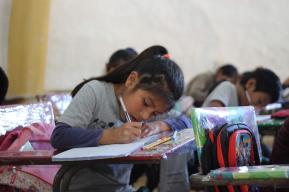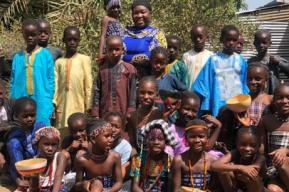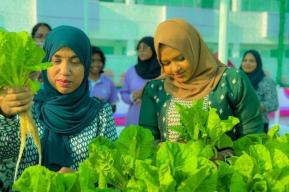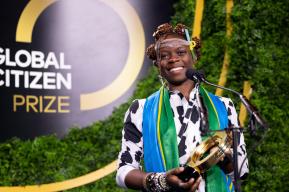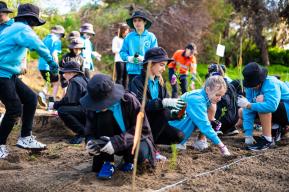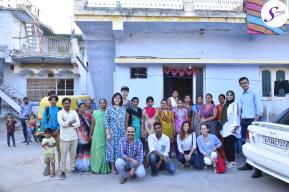In 2014, primary school teacher María Alicia was preparing her class for a field trip. She asked her primary students which animals they thought they might see on their way and during their adventure in the countryside. Cows, sheep, horses, dogs, pigs, and even giraffes and elephants were mentioned. Yet not a single child named an animal native to their homeland, Uruguay. They simply did not know of any.
There’s a mystery animal in our farm. It just leaves its footprints and dung. My parents say it’s a Pampas deer.
At the time, Ayelén traveled to school daily from her parents’ farmstead at the foot of the Cerro Áspero hill. Once their curiosity was piqued, Ayelén and her peers wanted to discover more about what the deer looked like, its features and habits, and whether the “mystery animal” was indeed a deer.
According to the teacher, listening to the interests of students is the key to unlocking knowledge and learning. She incorporated Ayelén’s interest into her teaching: A full-fledged classroom project centered on student-led research.
Families also demonstrated interest and engaged in the development of the project. They gradually took on research work, attended talks and meetings, and participated in fundraising events to support a class field trip to an active-science event at the Temaikén Foundation in Buenos Aires, Argentina.
Teacher María Alicia concluded that what initially seemed like a small community project now possessed the momentum to be expanded even further. Tras las huellas del venado, inspired by Education for Sustainable Development (ESD), was brought into the field of non-formal education in 2015. ESD aims to provide learners of all ages with the knowledge, skills, values, and power to address interconnected global challenges such as climate change, biodiversity loss, underwater disturbance, unsustainable resource use and inequality.
At this moment, let's follow this moment of revolution where we have been talking for a long time about innovation, about changes, about the need for different prototypes, about the need to see education in a different way and how to talk to children and families so that our work can be really fruitful.
The project transcended the boundaries of the classroom and became a visible, accessible adventure for anyone eager to become a part of biodiversity conservation efforts. Since then, children and teenagers have been proposing new initiatives for their community, conducting research, mapping socio-environmental problems, and devising plans to address them.
The project soon became community-wide, and included field trips and educational outings both within Uruguay and abroad, aiming to offer hands-on experiences across diverse landscapes and biomes. These fields visits were always preceded by thorough preparation from a multidisciplinary standpoint in such a way that the most can be made both before and after the trip.
Travelling groups can range between thirty and eighty people of all ages, genders, and backgrounds – many of whom have never got to travel abroad – united by a common goal: to embrace valuable, eye-witness experiences with nature. Tras las huellas del venado has catalyzed powerful exchanges, both culturally and educationally, at many locations such as the Temaikén Foundation (Buenos Aires and Misiones, Argentina), Itaipú Binational (Brazil-Paraguay), and Bosque Santiago (Chile).
Moreover, Tras las huellas del venado has promoted values such as respect, tolerance, and understanding prompting rich connections not only at the intergenerational level, but also with sister organizations. Since 2018, the group has become a member of the Jane Goodall Institute community action programme Roots & Shoots.
When the COVID-19 pandemic struck Uruguay, Tras las huellas del venado transformed challenges into opportunities by inviting Latin American and Caribbean environmental educators to step into virtual platforms and carry out weekly workshops that rotated around host cities and countries. New alliances soon flourished with organizations joining from Argentina, Guatemala, Puerto Rico, Mexico, Colombia, and Chile. Children started developing and improving their ICT skills, broadening their communicative competence, and most importantly, sharing their experiences with other children with similar interest and backgrounds.
Beyond field trips, in 2020, Tras las huellas del venado has partnered with Latin American organizations, universities, and schools to organize online talks to raise awareness on environmental protection and preservation, as well as provide opportunities for children and teenagers to collaboratively monitor wildlife with scientists.
Given Tras las huellas del venado’s immense contributions to ESD and potential to be upscaled, the UNESCO Regional Office for Latin America and the Caribbean (OREALC/UNESCO) has advocated for the project to be mainstreamed globally. Such efforts have included inviting teacher María Alicia to represent the organization at the regional launch of ESD for 2030; hosting a webinar series on ESD and youth in 2021; and presenting Tras las huellas del venado’s inspiring practices at a side event of the UNESCO 2021 World Conference on Education for Sustainable Development.
Tras las huellas del venado is a collective, participative movement led by children and teenagers. Through increasing autonomy, they have come to build their own processes by learning about their strengths and their challenges, a metacognitive process ushered by natural play, discovery of their environs and encounter with others. Through these many collective experiences, empowered children explore, analyze, make decisions, and take action for sustainable development. They develop core skills such as teamwork, intercultural fluency, and leadership.
- Interested in collaborating with the Tras las huellas del venado? Contact montevideo@unesco.org
- More on UNESCO’s work in education for sustainable development


